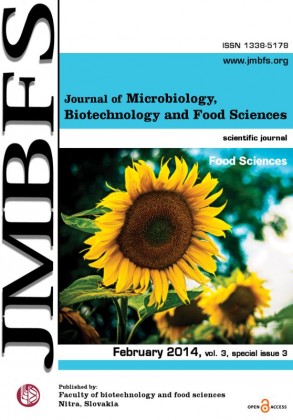THE EFFECT OF SURFACE MOULD APPLICATION TO SELECTED PROPERTIES OF DRY FERMENTED SAUSAGES
Keywords:
Mould culture, pH value, water activity, lactic acid, biogenic amines, TBARSAbstract
Three batches of dry fermented sausages were prepared. A proportion of the products from each batch were surface-treated with a mould starter culture, with the remaining products being smoked without mould. Physico-chemical analysis, including determination of the content of lactic acid and biogenic amines, was performed on day 35 during the ripening and on the final products (day 65). The sausages with surface mould showed a higher pH value, a higher water activity value and a lower content of D/L-lactic acid. The differences were statistically significant (P ≤ 0.001). A higher content of malondialdehyde (TBARS) was found in products with mould, though the differences determined were not statistically significant. From day 35, statistically significant differences were found in the content of biogenic amines (BA). The highest content was recorded on day 65 in sausages with surface mould, with a content seven times that of the content in the mix immediately after being filled in the casing being recorded. In no case did the sum level of BA exceed 100 mg kg-1.Downloads
Download data is not yet available.
Downloads
Published
2014-02-01
How to Cite
KamenÃk, J., Saláková, A., Borkovcová, I., PavlÃk, Z., & Vorlová, L. (2014). THE EFFECT OF SURFACE MOULD APPLICATION TO SELECTED PROPERTIES OF DRY FERMENTED SAUSAGES. Journal of Microbiology, Biotechnology and Food Sciences, 3(special issue 3 (Food Sciences), 22–27. Retrieved from https://office2.jmbfs.org/index.php/JMBFS/article/view/7565
Issue
Section
Food Sciences
License
Copyright (c) 2014 Josef KamenÃk, Alena Saláková, Ivana Borkovcová, Zdeněk PavlÃk, Lenka Vorlová

This work is licensed under a Creative Commons Attribution 4.0 International License.
All papers published in the Journal of Microbiology, Biotechnology and Food Sciences are published under a CC-BY licence (CC-BY 4.0). Published materials can be shared (copy and redistribute the material in any medium or format) and adapted (remix, transform, and build upon the material for any purpose, even commercially) with specifying the author(s).

